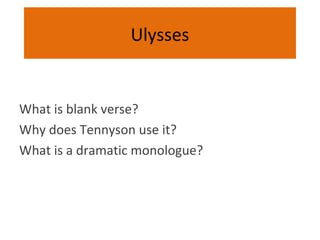
Ulysses
- 1. Ulysses What is blank verse? Why does Tennyson use it? What is a dramatic monologue?
- 2. Fragments: what is this poem about? Which of these uses of language is the most interesting and why? Can you find any connections to any of the previous poems? • barren crags, • Beyond the utmost bound of human thought. • He works his work, I mine. • How dull it is to pause • I am become a name; • I cannot rest • I have enjoy'd greatly, have suffer'd greatly • Most blameless is he • Some work of noble note, may yet be done, • This is my son • To follow knowledge like a sinking star, • To strive, to seek, to find, and not to yield. • you and I are old;
- 3. Form • Blank verse = iambic pentameter conversational tone/pattern of everyday speech – But regular rhythm interrupted (why?): • E.g. spondees (‘…I mine’…) forcefulness • Dramatic monologue: single speaker – To whom is Ulysses speaking? • Contemplative soliloquy? Or address? • Does the poem move from soliloquy to address? • Does the poem move location?
- 4. Structure • 70 lines, divided into three verse paragraphs. • Can a four-part division be made? – rejection of his barren life – first five lines – fond recall of heroic past end of first verse – dismissal/recognition of Telemachus’ governance – consideration given to another journey • How long is each section? What does this tell us? • Which sections use least enjambment? Are most monosyllabic? Why?
- 5. Run-on lines, caesurae • Use of enjambment (run-on lines) vs short declarative sentences. – Enjambed lines (e.g. ‘All experience…) • does he sometimes run away with himself? • does he like the sound of his own voice? – Short sentences, often monosyllabic (e.g. ‘He works his work, I mine.’ • creates abrupt/blunt tone – Overall impact: stop/go feeling is created…when is he expansive, when brief? • Caesurae or mid-line pauses (sing. Caesura) – E.g. ‘The long day wanes: the slow moon climbs: the deep/moans…’ – Perhaps builds reflective/meditative mood/slows pacing down
- 6. Antithesis • Contrasting of opposites in parallel phrases – ‘rust unburnishd’/’shine in use’ – ‘I have enjoyed greatly, have suffered greatly’ – ‘little remains…something more’ • tone – Discursive? – Meditative? – Inwardly debating?
- 7. Language • Consider each verse paragraph in turn – Image-clusters? – Key images? – Extended metaphors? Similes? – Use of sound • Use of monosyllable: – ‘hoard and sleep and feed and know not me’ etc • Tone of voice?
- 8. Tensions, Questions • Heroic/Bronze age Greece vs…? • How should we view Ulysses? – resolute and heroic? – as running away from his responsibilities? – heroic zeal or foolish excess? • View of self? View of others? – Egoism or recognition of abilities? – Contempt, condescension?
- 9. a) Question – Form, Structure, Language • How does Tennyson tell the story of Ulysses? – Consider his choice of FORM – Consider the STRUCTURE he uses – Consider the SPECIFIC LANGUAGE of the poem – Consider how the character of Ulysses is presented
- 10. Homework – due next Friday 1. Complete your notes (They should be clearly labeled in your books): – sound patterns – men & women – the past vs the present 1. Choose at least one of the following: – the use of sound (including alliteration, assonance and spondees) – the use of repetition and anaphora – representations of men & women – representations of life and death • and write about how Tennyson uses/explores your chosen focus in the poems you have studied so far. You may make comparisons, you may write about each poem separately. You may use notes you have made to help you, but it should be written as your own ideas! • For example: Tennyson’s use of sound in ‘Mariana’ helps to reinforce her isolation and loneliness. The use of assonance creates an echo which is then inflated by the repeated rhyme pattern in the verses. This is similar to the way that Shalott is described… However, in ‘Tithonus’ the use of spondee creates a sense of the weariness felt by the speaker…